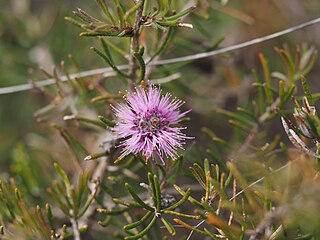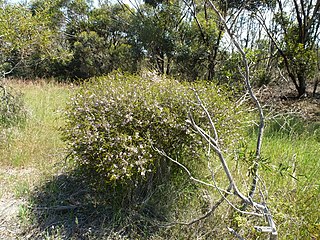Melaleuca penicula is a plant in the myrtle family, Myrtaceae and is endemic to the south of Western Australia. It is a rare species only known from the Fitzgerald River National Park and resembles Melaleuca eximia with its spikes of red flowers but its leaves and stamen bundles are different.
Melaleuca eximia is a plant in the myrtle family, Myrtaceae and is endemic to the south of Western Australia. It is distinguished by its leaf arrangement, its large, showy red inflorescences and the large, furry bracts under the flowers.

Melaleuca fabri is a plant in the myrtle family, Myrtaceae and is endemic to the south-west of Western Australia. It features strap-like leaves with distinct veins and spikes of pinkish flowers, the buds of which are covered with short, soft, silky hairs.

Melaleuca hnatiukii is a plant in the myrtle family, Myrtaceae and is endemic to the south of Western Australia. It is a medium to large shrub with arching branches, prickly tipped leaves and creamy-white heads of flowers in spring or early summer.

Melaleuca leuropoma is a plant in the myrtle family, Myrtaceae and is endemic to the south-west of Western Australia. It is a small to medium-sized shrub which flowers over an extended period with flower colour varying from purple to yellow or white. The glossy, often brown petals covering the flower buds are also an unusual characteristic of this species.

Melaleuca linguiformis is a plant in the myrtle family, Myrtaceae and is endemic to the south of Western Australia. It is a shrub with hairy new growth, small leaves and heads of white flowers similar to Melaleuca teuthidoides shorter sepals and more stamens in each flower.

Melaleuca podiocarpa is a plant in the myrtle family, Myrtaceae and is endemic to the south-west of Western Australia. It is a spreading shrub with prickly foliage and small heads of white flowers mostly hidden within the foliage.
Melaleuca procera is a plant in the myrtle family, Myrtaceae and is endemic to the south-west of Western Australia. It is an erect, spindly shrub with cylinder-shaped leaves and heads of pinkish flowers in later spring or early summer.

Melaleuca sapientes is a plant in the myrtle family, Myrtaceae, endemic to the south-west of Western Australia. It is a small shrub with silky grey leaves and small heads of pinkish flowers in spring or early summer. The attractive, silvery foliage has made this melaleuca a popular garden plant under the incorrect name of Melaleuca holosericea, a similar but much rarer species.
Melaleuca similis is a plant in the myrtle family, Myrtaceae and is endemic to the south west of Western Australia. It is a small shrub, similar to Melaleuca stramentosa with its narrow, almost cylindrical leaves and heads of pink to purple flowers but lacks the matted, silky hairs on the young leaves and outer edge of the flower cup.

Melaleuca tinkeri is a plant in the myrtle family, Myrtaceae and is endemic to the south-west of Western Australia. It is one of the smallest melaleucas and is distinguished by its warty, hairy leaves, heads of pinkish flowers in late winter to spring and its spherical fruiting clusters.

Melaleuca strobophylla is a shrub or small tree in the myrtle family Myrtaceae and is endemic to the south-west of Western Australia. It has papery bark, sharply pointed, twisted leaves and rather long spikes of creamy white flowers in summer.
Melaleuca adenostyla is a plant in the myrtle family, Myrtaceae and is endemic to the south-west of Western Australia. It is a large, broom-like shrub to about 5 metres (16 ft) high with narrow leaves and cream-coloured flowers and which often grows in saline places.

Melaleuca coccinea, commonly known as the goldfields bottlebrush is a shrub in the myrtle family Myrtaceae and is endemic the south of Western Australia. It is distinguished by its unusual foliage and bottlebrush spikes of red flowers.

Melaleuca camptoclada is a shrub in the myrtle family, Myrtaceae and is endemic to the south-west of Western Australia. It was first described in 1990 in a review of the genus Melaleuca when the species Melaleuca laxiflora at that time was found to comprise ten species. Two of those species were new - M. camptoclada and M. ctenoides.

Melaleuca ctenoides is a shrub in the myrtle family, Myrtaceae and is endemic to the south-west of Western Australia. It was first described in 1990 in a review of the genus Melaleuca when the species M. laxiflora at that time was found to comprise ten species. Two of those species were new - M. camptoclada and M. ctenoides. It similar to Melaleuca laxiflora but distinguished from it by its comb-like leaves and attractive mauve or violet flowers in spring.
Melaleuca ochroma is a plant in the myrtle family, Myrtaceae, and is endemic to the south-west of Western Australia. It is very similar to Melaleuca subfalcata, varying mainly in the length of its stamens and styles. Like M. subfalcata, it has pink to mauve flowers and leaves that are very hairy when young but become glabrous when mature.

Melaleuca teuthidoides is a plant in the myrtle family, Myrtaceae and is endemic to the south of Western Australia. It is a shrub with rough bark and heads of white flowers on the ends of its branches in spring and early summer.
Melaleuca calcicola is a plant in the myrtle family, Myrtaceae and is endemic to the south of Western Australia. It was formerly known as a subspecies of Melaleuca apodocephala but was reassessed in 2010 and raised to species status. Its branches are corky, the leaves pointed although not prickly and the flowers are creamy white, tipped with yellow.
Melaleuca genialis is a plant in the myrtle family, Myrtaceae, and is endemic to the south-west of Western Australia. It is a rare species, known from one nature reserve. It is similar to Melaleuca tinkeri, mainly differing from it in having hairy leaves and petals.














